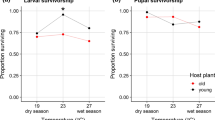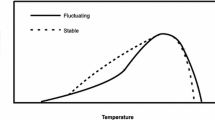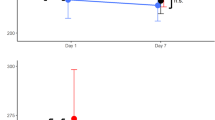Abstract
Temperature is an important selective agent in nature. Consequently, temperature-induced plasticity which may help buffering detrimental effects of temperature variation has received considerable attention over recent decades. Laboratory studies have almost exclusively used constant temperatures, while in nature, temperature typically shows pronounced daily fluctuations. Using a factorial design with constant versus fluctuating temperatures and a higher versus a lower mean temperature, we here investigate in the butterfly Lycaena tityrus whether the use of constant temperatures is justified. Fluctuating compared to constant temperatures caused shorter development times, increased heat but decreased cold stress resistance, decreased heat-shock protein expression, and increased immunocompetence. Thus, overall, fluctuating temperatures were more beneficial to the butterflies compared to constant ones. However, despite substantial variation across temperature regimes, the ranking of trait values among treatments remained largely unaffected (e.g. lower constant as well as fluctuating temperatures caused increased pupal mass). Thus, we tentatively conclude that there is no general reason for concern about using constant temperatures in studies investigating phenotypic plasticity, which seem to comprise a fair proxy. However, substantial differences in mean values as well as interactive effects suggest that one needs to be cautious. We further demonstrate negative effects of high temperatures on butterfly immune function, which seem to result from a trade-off between the latter and the heat shock response.



Similar content being viewed by others
References
Adamo SA, Parsons NM (2006) The emergency life-history stage and immunity in the cricket Gryllus texensis. Anim Behav 72:235–244
Angilletta MJ Jr (2009) Thermal adaptation. A theoretical and empirical synthesis. Oxford Univesrity Press, New York
Angilletta MJ Jr, Niewiarowski PH, Navas CA (2002) The evolution of thermal physiology in ectotherms. J Thermal Biol 27:249–268
Atkinson D (1994) Temperature and organism size—a biological law for ectotherms. Adv Ecol Res 25:1–58
Bahrndorff S, Maien J, Loeschcke V, Ellers J (2009) Dynamics of heat-induced thermal stress resistance and Hsp70-expression in the springtail, Orchesella cincta. Funct Ecol 23:233–239
Beck SD (1983) Insect thermoperiodism. Annu Rev Entomol 28:91–108
Behrens W, Hoffmann KH, Kempa S, Gabler S, Merkel-Wallner G (1983) Effects of diurnal thermoperiods and quickly oscillating temperatures on the development and reproduction of crickets, Gryllus bimaculatus. Oecologia 59:279–287
Berwaerts K, Van Dyck H (2004) Take-off performance under optimal and suboptimal thermal conditions in the butterfly Pararge aegeria. Oecologia 141:536–545
Bonneaud C, Mazuc J, Gonzalez G, Haussy C, Chastel O, Faivre B, Sorci G (2003) Assessing the cost of mounting an immune response. Am Nat 161:367–379
Bradford MM (1976) A rapid and sensitive method for the quantisation of microgram quantities of protein utilizing the principle of protein-dye binding. Anal Biochem 72:248–254
Brakefield PM, Kesbeke F (1997) Genotype–environment interactions for insect growth in constant and fluctuating temperature regimes. Proc R Soc Lond B 264:717–723
Brakefield PM, Mazzotta V (1995) Matching field and laboratory environments: effects of neglecting daily temperature variation on insect reaction norms. J Evol Biol 8:559–573
Castañeda L, Lardies MA, Bozinovic F (2005) Interpopulational variation in recovery time from chill coma along a geographic gradient: a study in the common woodlouse, Porcellio laevis. J Insect Physiol 51:1346–1351
Chen CP, Denlinger DL (1992) Reduction of cold injury in flies using an intermittent pulse of high temperature. Cryobiology 29:138–143
Chown SL, Terblanche JS (2007) Physiological diversity in insects: ecological and evolutionary contexts. Adv Insect Physiol 33:50–152
Chown SL, Jumbam KR, Sørensen JG, Terblanche JS (2009) Phenotypic variance, plasticity and heritability estimates of critical thermal limits depend on methodological context. Funct Ecol 23:133–140
Clarke A (2003) Costs and consequences of evolutionary temperature adaptation. Trends Ecol Evol 18:573–581
Clarke A (2006) Temperature and the metabolic theory of ecology. Funct Ecol 20:405–412
Colinet H, An Nguyen TT, Cloutier C, Michaud D, Hance T (2007) Proteomic profiling of a parasitic wasp exposed to constant and fluctuating cold exposure. Insect Biochem Mol Biol 37:1177–1188
Dahlgaard J, Loeschcke V, Michalak P, Justesen J (1998) Induced thermotolerance and associated expression of the heat-shock protein Hsp70 in adult Drosophila melanogaster. Funct Ecol 12:786–793
Danks HV (2005) Key themes in the study of seasonal adaptations in insects. I. Patterns of cold hardiness. Appl Entomol Zool 40:199–211
De Block M, Stoks R (2008) Short-term larval food stress and associated compensatory growth reduce adult immune function in a damselfly. Ecol Entomol 33:796–801
Deere JA, Sinclair BJ, Marshall DJ, Chown SL (2006) Phenotypic plasticity of thermal tolerances in five oribatid mite species from sub-Antarctic Marion Island. J Insect Physiol 52:693–700
Ebert G, Rennwald E (1991) Die Schmetterlinge Baden-Württembergs, vol 2. Ulmer, Stuttgart
Fischer K, Fiedler K (2000) Sex-related differences in reaction norms in the butterfly Lycaena tityrus (Lepidoptera: Lycaenidae). Oikos 90:372–380
Fischer K, Fiedler K (2001) Dimorphic growth patterns and sex-specific reaction norms in the butterfly Lycaena hippothoe sumadiensis. J Evol Biol 14:210–218
Fischer K, Fiedler K (2002) Reaction norms for age and size at maturity in response to temperature: a test of the compound interest hypothesis. Evol Ecol 16:333–349
Fischer K, Karl I (2010) Exploring plastic and genetic responses to temperature variation using Copper butterflies. Clim Res 43:17–30
Fischer K, Brakefield PM, Zwaan BJ (2003) Plasticity in butterfly egg size: why larger offspring at lower temperatures? Ecology 84:3138–3147
Geister TL, Fischer K (2007) Testing the beneficial acclimation hypothesis: temperature effects on mating success in a butterfly. Behav Ecol 18:658–664
Gibert P, Moreteau B, Petavy G, Karan D, David JR (2001) Chill coma tolerance: a major climatic adaptation among Drosophila species. Evolution 55:1063–1068
Hochachka PW, Somero GN (2002) Biochemical adaptation. Mechanism and process in physiological evolution. Oxford University Press, New York
Hoffmann AA, Sørensen JG, Loeschcke V (2003) Adaptation of Drosophila to temperature extremes: bringing together quantitative and molecular approaches. J Therm Biol 28:175–216
Honek A (1993) Intraspecific variation in body size and fecundity in insects: a general relationship. Oikos 66:483–492
Karl I, Fischer K (2008) Why get big in the cold? Towards a solution of a life-history puzzle. Oecologia 155:215–225
Karl I, Janowitz SA, Fischer K (2008a) Altitudinal life-history variation and thermal adaptation in the copper butterfly Lycaena tityrus. Oikos 117:778–788
Karl I, Schmitt T, Fischer K (2008b) Phosphoglucose isomerase genotype affects life-history traits and cold stress resistance in a Copper butterfly. Funct Ecol 22:887–894
Karl I, Sørensen JG, Loeschcke V, Fischer K (2009) HSP70 expression in the copper butterfly Lycaena tityrus across altitudes and temperatures. J Evol Biol 22:172–178
Karl I, Stoks R, De Block M, Janowitz SA, Fischer K (2011) Temperature extremes and butterfly fitness: conflicting evidence from life history and immune function. Glob Change Biol 17:676–687
Kingsolver JG, Woods HA (1997) Thermal sensitivity of growth and feeding in Manduca sexta caterpillars. Physiol Zool 70:631–638
Krebs RA, Loeschcke V (1994) Costs and benefits of activation of the heat-shock response in Drosophila melanogaster. Funct Ecol 8:730–737
Kurtz J, Sauer KP (2001) Gender differences in phenoloxidase activity of Panorpa vulgaris hemocytes. J Invert Pathol 78:53–55
Loeschcke V, Hoffmann AA (2007) Consequences of heat hardening on a field fitness component in Drosophila depend on environmental temperature. Am Nat 169:175–183
Loeschcke V, Krebs RA, Dahlgaard J, Michalak P (1997) High-temperature stress and the evolution of thermal resistance in Drosophila. In: Bijlsma R, Loeschcke V (eds) Environmental stress. Adaptation and evolution. Birkhäuser, Basel, pp 175–189
Nedved O, Lavy D, Verhoef HA (1998) Modeling the time-temperature relationship in cold injury and effect of high-temperature interruptions on survival in a chill-sensitive collembolan. Funct Ecol 12:816–824
Nielsen MM, Overgaard J, Sorensen JG, Holmstrup M, Justesen J, Loeschcke V (2005) Role of HSF activation for resistance to heat, cold and high-temperature knock-down. J Insect Physiol 51:1320–1329
Petavy G, David JR, Gibert P, Moreteau B (2001a) Viability and rate of development at different temperatures in Drosophila: a comparison of constant and alternating regimes. J Therm Biol 26:29–39
Petavy G, Moreteau B, Gibert P, Morin JP, David JR (2001b) Phenotypic plasticity of body size in Drosophila: effects of a daily periodicity of growth temperature in two sibling species. Physiol Entomol 26:351–361
Rajamohan A, Sinclair BJ (2009) Hardening trumps acclimation in improving cold tolerance of Drosophila melanogaster larvae. Physiol Entomol 34:217–223
Renault D, Salin C, Vannier G, Vernon P (2002) Survival at low temperatures in insects: what is the ecological significance of the supercooling point? Cryoletters 23:217–228
Roff DA (2002) The evolution of life-histories. Theory and analysis. Chapman and Hall, New York
Rolff J, Van de Meutter F, Stoks R (2004) Time constraints decouple age and size at maturity and physiological traits. Am Nat 64:559–565
Schmid-Hempel P (2003) Variation in immune defence as a question of evolutionary ecology. Proc R Soc Lond B 270:357–366
Schwartz A, Koella JC (2004) The cost of immunity in the yellow fever mosquito, Aedes aegypti depends on immune activation. J Evol Biol 17:834–840
Sheldon BC, Verhulst S (1996) Ecological immunology: costly parasite defences and trade-offs in evolutionary ecology. Trends Ecol Evol 11:317–321
Siddiqui WH, Barlow CA (1972) Population growth of Drosophila melanogaster (Diptera: Drosophilidae) at constant and alternating temperatures. Ann Entomol Soc Am 65:993–1001
Sinclair BJ, Vernon P, Klok CJ, Chown SL (2003) Insects at low temperatures: an ecological perspective. Trends Ecol Evol 18:257–262
Sørensen JG, Kristensen TN, Loeschcke V (2003) The evolutionary and ecological role of heat shock proteins. Ecol Lett 6:1025–1037
Sørensen JG, Norry FM, Scannapeico AC, Loeschcke V (2005) Altitudinal variation for stress resistance traits and thermal adaptation in adult Drosophila buzzatii from the New World. J Evol Biol 18:829–837
Stoks R, De Block M, Slos S, Van Doorslaer W, Rolff J (2006) Time constraints mediate predator-induced plasticity in immune function, condition, and life history. Ecology 87:809–815
Tolman T, Lewington R (1998) Die Tagfalter Europas und Nordwestafrikas. Franckh-Kosmos, Stuttgart
Wiklund C, Fagerström T (1977) Why do males emerge before females? A hypothesis to explain the incidence of protandry in butterflies. Oecologia 31:153–158
Willmer P, Stone G, Johnston IA (2000) Environmental physiology of animals. Wiley/Blackwell, Oxford
Worner SP (1992) Performance of phenological models under variable temperature regimes: consequences of the Kaufmann rate summation effect. Environ Entomol 21:689–699
Zeilstra I, Fischer K (2005) Cold tolerance in relation to developmental and adult temperature in a butterfly. Physiol Entomol 30:92–95
Zuk M, McKean KA (1996) Sex differences in parasite infections: patterns and processes. Intern J Parasitol 26:1009–1023
Acknowledgments
This study was supported by a start-up fund from Greifswald University. We thank Christin Michalowsky for excellent technical assistance, and Sarah Winter for help with butterfly rearing.
Author information
Authors and Affiliations
Corresponding author
Additional information
Communicated by Jérome Casas.
Rights and permissions
About this article
Cite this article
Fischer, K., Kölzow, N., Höltje, H. et al. Assay conditions in laboratory experiments: is the use of constant rather than fluctuating temperatures justified when investigating temperature-induced plasticity?. Oecologia 166, 23–33 (2011). https://doi.org/10.1007/s00442-011-1917-0
Received:
Accepted:
Published:
Issue Date:
DOI: https://doi.org/10.1007/s00442-011-1917-0




